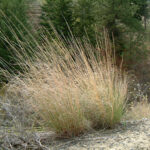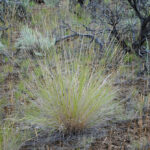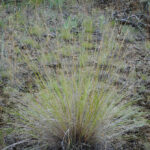Bluebunch Wheatgrass
Pseudoroegneria spicata
General Description
Bluebunch wheatgrass is a native, perennial, cool season bunchgrass with fibrous roots, sometimes forming clumps as wide as 150 cm (59 in). Stems range from 60 to 130 cm (24 to 51 in) tall, with narrow leaves mostly originating from the stem. Bluebunch wheatgrass reproduces primarily through seed but may reproduce vegetatively with short rhizomes on wetter sites. Bluebunch wheatgrass is an important species in British Columbia grasslands, occurring mostly in the south, central, and southeast parts of the province. It has historical importance in the development of the livestock industry in British Columbia because of its value for fall and winter grazing. It is also an important indicator of good ecological condition.
Type
Native grass.
Origin
Bluebunch wheatgrass is native to British Columbia.
Longevity
Bluebunch wheatgrass is long lived.
Use
Reclamation, grazing. As an important native component in B.C. grasslands, bluebunch wheatgrass is an important species for consideration in reclamation and restoration. It provides valuable forage for wildlife and all types of livestock.
Optimal Time of Use
Bluebunch wheatgrass can support grazing in all seasons. Sufficient growth should be allowed before grazing bluebunch wheatgrass in the spring. At least 15 cm (6 in) of growth or allowing plants to reach the 4-leaf stage of development is recommended. Spring use should be deferred or alternated to fall use every 2–3 years. New stands should be well established (2–3 growing seasons) before grazing is allowed.
Recovery After Use
Repeated defoliation during the spring growth period is likely to reduce plant vigour, and lead to plant mortality (see McLean and Wikeem 1985). Suitable regrowth is likely to occur with late summer or fall rain if proper utilization (40–50% of growth) is applied in the spring season.
Forage yield will vary depending on the location and composition of the stand. McLean and Bawtree (1982) reported a yield of 660 kg/ha (589 lb/acre) in a mixed native stand (with needle-and-thread grass) on a mid-elevation (850 m) (2,789 ft) site near Kamloops, B.C.
Palatability/Nutritional Value
Bluebunch wheatgrass is highly palatable to livestock and wildlife and provides good winter forage when rested during the growing season. Plants remain green well into summer. Crude protein of green leaf material sampled in May was 15%, and cured material sampled in November was 3% in the Kamloops area (McLean and Bawtree 1982).
Annual Precipitation min/max (mm)
200mm / 500mm
Drought Tolerance
Bluebunch wheatgrass is very drought tolerant.
Flooding Tolerance
Bluebunch wheatgrass is not tolerant of high water tables, saturated soils, or flooding.
Winter Hardiness
Bluebunch wheatgrass does best on medium-coarse textured soils, but also can be found on heavy- to medium- to coarse-textured soils.
Soil Texture Preference
Bluebunch wheatgrass does best on medium-coarse textured soils, but also can be found on heavy- to medium- to coarse-textured soils.
Erosion Control
Bluebunch wheatgrass can provide some erosion control on dry, disturbed sites where native vegetation is desired, but is not noted for erosion control.
Salinity Tolerance
Low tolerance. Bluebunch wheatgrass will tolerate weakly saline conditions.
Acidity Tolerance
Low tolerance. Bluebunch wheatgrass does not grow on moderate to highly acidic sites.
Alkalinity Tolerance
Not reported.
Seeds per kg
331,000 seeds/kg (150,139 seeds/lb)
Suggested Mixtures
Bluebunch wheatgrass should be seeded with other suitable native species, rather than with more competitive introduced species.
Ease of Establishment
Bluebunch wheatgrass is more difficult to establish than other native wheatgrasses. Seedbed preparation followed by drill seeding at depths of 0.6 to 1.27 cm (1/4 to 1/2 in.) produce the best results, but this method is likely to be unsuited to most projects and site conditions found in British Columbia. Broadcast seeding is likely to be more applicable, but establishment may be slow, and results mixed. Some B.C. restoration practitioners have used vegetative or plug plantings. Hay seeding using locally sourced plant materials was applied with marginal results on a restoration project in the South Okanagan.
Competitiveness
Bluebunch wheatgrass is reasonably competitive when it is well established in naturally occurring native plant communities.
Management Considerations
Bluebunch wheatgrass does not tolerate heavy, continuous grazing. A rest or deferred rotation grazing system is recommended to keep this grass in a healthy and vigorous condition.
BC Rangeland Seeding Manual, USDA Plants Database
Bluebunch wheatgrass is adapted to dryland range, restoration and reclamation applications where native species are desired in the low-mid elevation areas in the Bunchgrass and Interior Douglas-fir zones in the southern part of the Central Interior region.
Bluebunch wheatgrass is adapted to dryland range, restoration and reclamation applications where native species are desired in the low-mid elevation areas in the Bunchgrass, Ponderosa Pine and Interior Douglas-fir zones.


